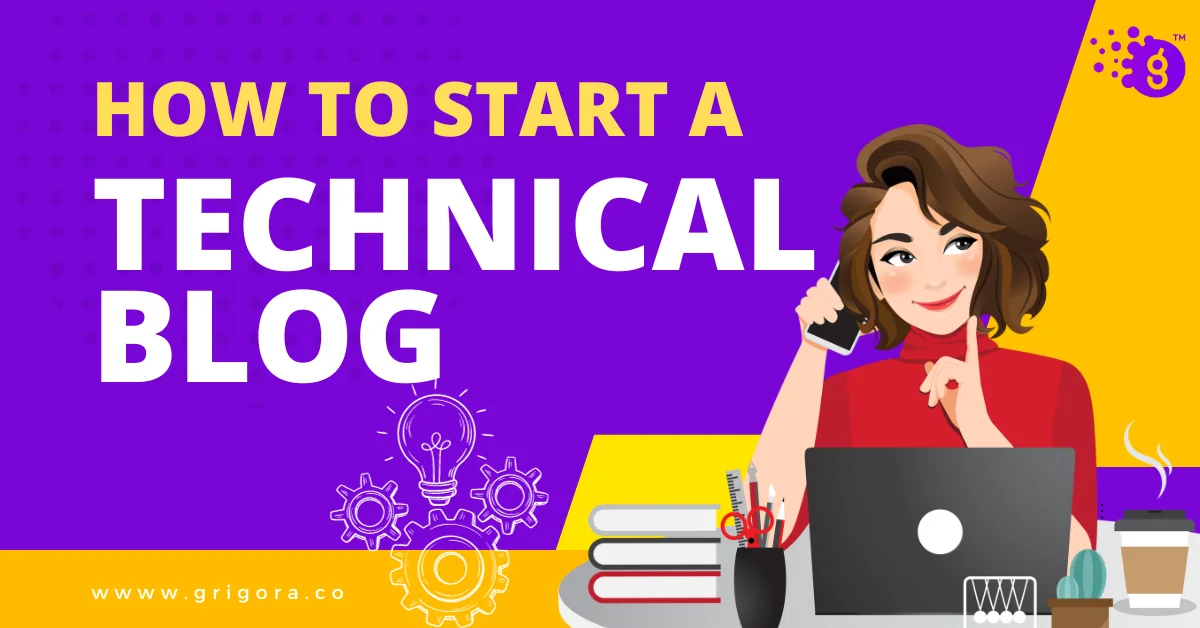Introduction
"In technology, sharing knowledge is not an option; it is a responsibility." This quote encapsulates the essence of why technical blogs are not just beneficial but essential in the fast-paced world of technology.
The Importance of Technical Blogs in the Tech Industry
Technical blogs serve as a vital resource for professionals, students, and enthusiasts alike. They offer insights into new technologies, best practices, and industry trends. By sharing your expertise through a technical blog, you're contributing to a broader community of learning and development.
Benefits and Challenges of Starting a Technical Blog
Starting a technical blog comes with its set of rewards and challenges. On the one hand, it establishes you as an authority in your field and can even open doors for career opportunities. On the flip side, maintaining a blog requires a significant time investment and a commitment to continuous learning.
What to Consider Before Launching Your Technical Blog
Before you dive into blogging, consider your area of expertise, the audience you want to target, and the kind of content you wish to produce. These factors will guide the direction of your blog and help you create more focused and relevant content.
Identifying Your Niche
Choosing a specific area of focus is crucial for the success of your technical blog. A well-defined niche not only helps you stand out but also attracts a more targeted audience.
Choosing a Specific Technology or Field
Selecting a niche is the first step in creating a blog that provides value. Whether you're an expert in machine learning, web development, or cybersecurity, your niche should reflect your expertise and passion.
Understanding Your Target Audience
Knowing your audience is key to creating content that resonates. Are you targeting beginners, intermediates, or experts in your field? Understanding your audience's needs and pain points will guide your content strategy.
Setting Goals for Your Technical Blog
What do you hope to achieve with your blog? Whether it's sharing knowledge, building a portfolio, or even monetizing your content, having clear goals will keep you motivated and focused.
Choosing a Blogging Platform
Selecting the right platform is a critical decision that can significantly impact your blog's performance and scalability. Here's how to make an informed choice.
WordPress and Other Options
There are numerous platforms available for starting a blog, each with its own set of features and limitations. WordPress is often the go-to choice for its ease of use and extensive plugin ecosystem.
Pros and Cons of Free vs. Paid Platforms
Free platforms may seem tempting, but they often come with limitations such as lack of customization and control. Paid platforms offer more flexibility but come at a cost. Weigh the pros and cons carefully before making your decision.
Why Grigora is an Ideal Choice for Technical Blogs
Grigora stands out for its robust features tailored for technical blogging. With its user-friendly interface, customization options, and strong security measures, Grigora provides a comprehensive solution for aspiring technical bloggers.
Setting Up Your Blog
Once you've chosen your blogging platform, the next step is to set up your blog. This involves several key decisions, from selecting a domain name to designing your blog's layout.
Domain Name and Hosting
Choosing a Domain Name that Reflects Your Technical Expertise
Your domain name is your blog's online identity. Choose a name that not only resonates with your audience but also reflects your technical expertise. A well-thought-out domain name can also improve your blog's SEO.
Selecting a Reliable Hosting Service
Hosting is another crucial aspect of setting up your blog. Opt for a hosting service that offers excellent uptime, customer support, and scalability.
Blog Design and Layout
Choosing a Theme that Complements Your Technical Content
The design of your blog should align with the type of content you'll be publishing. Choose a theme that complements your technical content and enhances readability.
User-friendly Navigation and Accessibility
Ensure your blog is easy to navigate and accessible. A clean layout and intuitive navigation can significantly improve the user experience.
Essential Pages Every Technical Blog Should Have
Creating a blog goes beyond just churning out articles; it's about crafting a holistic user experience. This section delves into the essential pages that should be part of your technical blog.
About Page: Establishing Your Credibility
The "About" page is not just a mere introduction; it's your first handshake with your audience. This is where you establish your credibility by sharing your background, qualifications, and expertise in the technical domain. You can also outline what readers can expect from your blog, thereby setting the stage for future interactions.
Contact Page: Fostering Collaboration and Open Communication
A well-crafted "Contact" page serves multiple purposes. It's not just a gateway for feedback but also an open invitation for collaboration and professional opportunities. Providing multiple avenues for contact, such as email, a contact form, and social media links, makes it easier for your audience to reach you.
Grigora's User-Friendly Page Builder: Simplifying Page Creation
Creating these essential pages is simplified with Grigora's intuitive page builder. Grigora offers a plethora of templates and customization options, allowing you to create pages that resonate with your blog's overall aesthetic and objectives. The drag-and-drop interface is particularly beneficial for those who may not have coding skills but still desire a polished, professional look for their blog.
Crafting Content for Your Technical Blog
Content is the lifeblood of any blog, and in a technical blog, the stakes are even higher. Here's how to go about it:
Types of Content: Diversifying Your Portfolio
In the realm of technical blogging, variety is key. From in-depth tutorials and code reviews to insightful industry analyses, the type of content you produce should cater to the diverse needs and interests of your tech-savvy audience.
Utilizing Code Snippets and Visual Aids: Enhancing Comprehension
The effective use of code snippets, flowcharts, and diagrams is non-negotiable in a technical blog. These elements not only enrich your content but also serve as invaluable tools for simplifying complex technical jargon and concepts.
Staying Abreast of Technological Advancements: Ensuring Relevance
The tech landscape is ever-evolving, making it imperative for you to stay updated. Regularly revisiting and updating your older posts ensures that your content remains relevant and up-to-date.
Creating Content for Your Technical Blog
Types of Posts: Tutorials, Code Reviews, Industry Insights
Tutorials
One of the most effective ways to establish authority in your field is by creating tutorial posts. These step-by-step guides can help your readers solve specific problems or learn new skills.
Code Reviews
Sharing code reviews not only helps your readers but also establishes you as an expert who understands both the theory and practice of your field.
Industry Insights
Stay updated with the latest trends and technologies, and share your insights with your readers. This will not only keep your content fresh but also attract a more professional audience.
Using Code Snippets and Diagrams Effectively
Code Snippets
When discussing technical topics, code snippets can be incredibly helpful. Make sure to include these in your posts to clarify your points.
Diagrams
Complex topics often benefit from visual aids like diagrams or flowcharts. These can make your content more accessible and help explain concepts more clearly.
Staying Updated with Latest Technologies
The tech world is always evolving. Make sure you stay updated with the latest technologies and updates to keep your blog relevant.
Grigora's Content Management Tools
Grigora's User-Friendly Interface
Grigora offers a user-friendly interface that makes it easy to insert code snippets, upload diagrams, and manage your posts.
Customization Options
With Grigora, you can easily customize the look and feel of your content, making it more aligned with your brand and more engaging for your readers.
Engaging with Your Audience
Encouraging Comments and Discussions
Open the Floor to Your Readers
One of the best ways to engage with your audience is by encouraging comments and discussions at the end of your blog posts. This not only increases user engagement but also provides you with valuable feedback.
Social Media and Newsletters
Leverage Social Media
Social media platforms like Twitter, LinkedIn, and Facebook are excellent channels for promoting your content and interacting with your audience.
Newsletters
Sending out regular newsletters can help you keep your audience updated with your latest posts and any other important updates or announcements.
Collaborating with Other Tech Bloggers or Companies
Guest Posts and Collaborations
Collaborating with other bloggers or tech companies can provide fresh perspectives to your audience and also help in expanding your reach.
Monetizing Your Technical Blog
Affiliate Marketing for Tech Products
Turn Your Recommendations into Revenue
Affiliate marketing can be a lucrative way to monetize your technical blog. By recommending tech products that you genuinely find useful, you can earn a commission for every sale made through your referral link.
Selling E-books or Online Courses
Share Your Expertise for Profit
If you have a particular area of expertise, consider creating and selling e-books or online courses. This not only establishes you as an authority in your field but also provides an additional revenue stream.
Sponsored Posts and Partnerships
Collaborate for Cash
Sponsored posts and partnerships with tech companies can be another way to monetize your blog. However, it's crucial to maintain transparency with your audience about such collaborations.
Promoting Your Technical Blog
SEO Strategies for Technical Blogs
Optimize for Visibility
Search Engine Optimization (SEO) is crucial for any blog, and technical blogs are no exception. Utilize keywords effectively, create high-quality backlinks, and ensure that your site is mobile-friendly to improve your search engine rankings.
Guest Posting on Similar Blogs
Expand Your Reach
Guest posting on blogs that are related to your technical niche can help you reach a broader audience. It's a win-win situation where you provide valuable content for another blog and get exposure in return.
Utilizing Social Media Platforms
Harness the Power of Social Media
Social media platforms like Twitter, LinkedIn, and Reddit are excellent channels for promoting your technical content. Share snippets, updates, and engage with your audience to build a loyal following.
Maintaining and Updating Your Blog
Creating a Content Calendar
Stay Organized and Consistent
One of the challenges of running a technical blog is maintaining a consistent posting schedule. A content calendar can be a lifesaver in this regard. Plan your topics in advance and set deadlines to ensure you're consistently delivering valuable content to your readers.
Dealing with Writer’s Block and Burnout
Keep the Creative Juices Flowing
Writer's block and burnout are common issues that many bloggers face. Take short breaks, engage in activities that inspire you, and don't hesitate to seek feedback or collaborate with others to overcome these challenges.
Steps to Become a Tech Influencer in 30 Days
Day 1: Define Your Goals and Niche
Decide what you want to achieve with your blog.
Choose a specific technology or field you want to focus on.
Day 2: Research Your Target Audience
Identify the types of readers you want to attract.
Look at existing blogs in your niche to see what they're doing.
Day 3: Choose a Blogging Platform
Research various platforms like WordPress, Grigora.
Day 4: Purchase Domain and Hosting
Choose a domain name that reflects your technical expertise.
Select a reliable hosting service.
Day 5: Install Blogging Platform
Install your chosen blogging platform.
Day 6: Choose a Theme and Design Layout
Pick a theme that complements your technical content.
Grigora Highlight: Grigora offers a variety of themes tailored for technical blogs.
Day 7: Create Essential Pages
Add an 'About' page and a 'Contact' page.
Grigora Highlight: Use Grigora's easy-to-use page builder to create these pages.
Day 8-14: Content Creation
Start writing your first few blog posts.
Grigora Highlight: Use Grigora's content management tools to draft, edit, and publish your posts.
Day 15: Launch Your Blog
Make your blog live.
Share it on social media and tech forums.
Day 16-20: Audience Engagement
Start engaging with your audience through comments and social media.
Day 21-25: Basic SEO Setup
Implement basic SEO strategies like keyword optimization.
Day 26: Monetization Strategy
Research and decide on monetization methods like affiliate marketing or sponsored posts.
Day 27-29: Analyze and Tweak
Use analytics tools to track your blog's performance.
Day 30: Plan for the Next Month
Based on analytics and audience feedback, plan your strategy for the next month.
By following this 30-day plan, you'll be well on your way to starting a successful technical blog and becoming a tech influencer. Remember, consistency is key, and Grigora is here to make your blogging journey as smooth as possible.
Conclusion
The Rewards of Sharing Your Technical Knowledge
A Platform for Professional Growth
Starting and maintaining a technical blog is not just about sharing your knowledge; it's also an excellent platform for your professional growth. It establishes you as an authority in your field and opens doors for various opportunities like speaking engagements, collaborations, and even job offers.
Next Steps for Growing Your Blog and Community
Don't Stop at Blogging
Once your blog is up and running, consider expanding into other forms of content like podcasts, webinars, or YouTube videos. Diversifying your content will attract a broader audience and provide more value.
FAQs
How often should I update my technical blog?
Aim to update your blog at least once a week. Consistency helps in building a loyal readership and improves your blog's SEO.
Do I need professional writing skills to start a technical blog?
While good writing skills are a plus, they are not a necessity. What matters most is the quality and accuracy of the technical content you provide.
How do I handle complex technical topics?
Complex topics can be broken down into a series of blog posts or explained using diagrams, code snippets, and examples to make them more digestible.
What are the best practices for SEO on a technical blog?
Use keyword research, meta descriptions, and quality backlinks as part of your SEO strategy. Grigora's SEO tools can assist in optimizing your blog for search engines.
How can Grigora assist in technical blogging?
Grigora provides an all-in-one platform for hosting, content management, SEO, and analytics, making it easier for you to manage and grow your technical blog.



